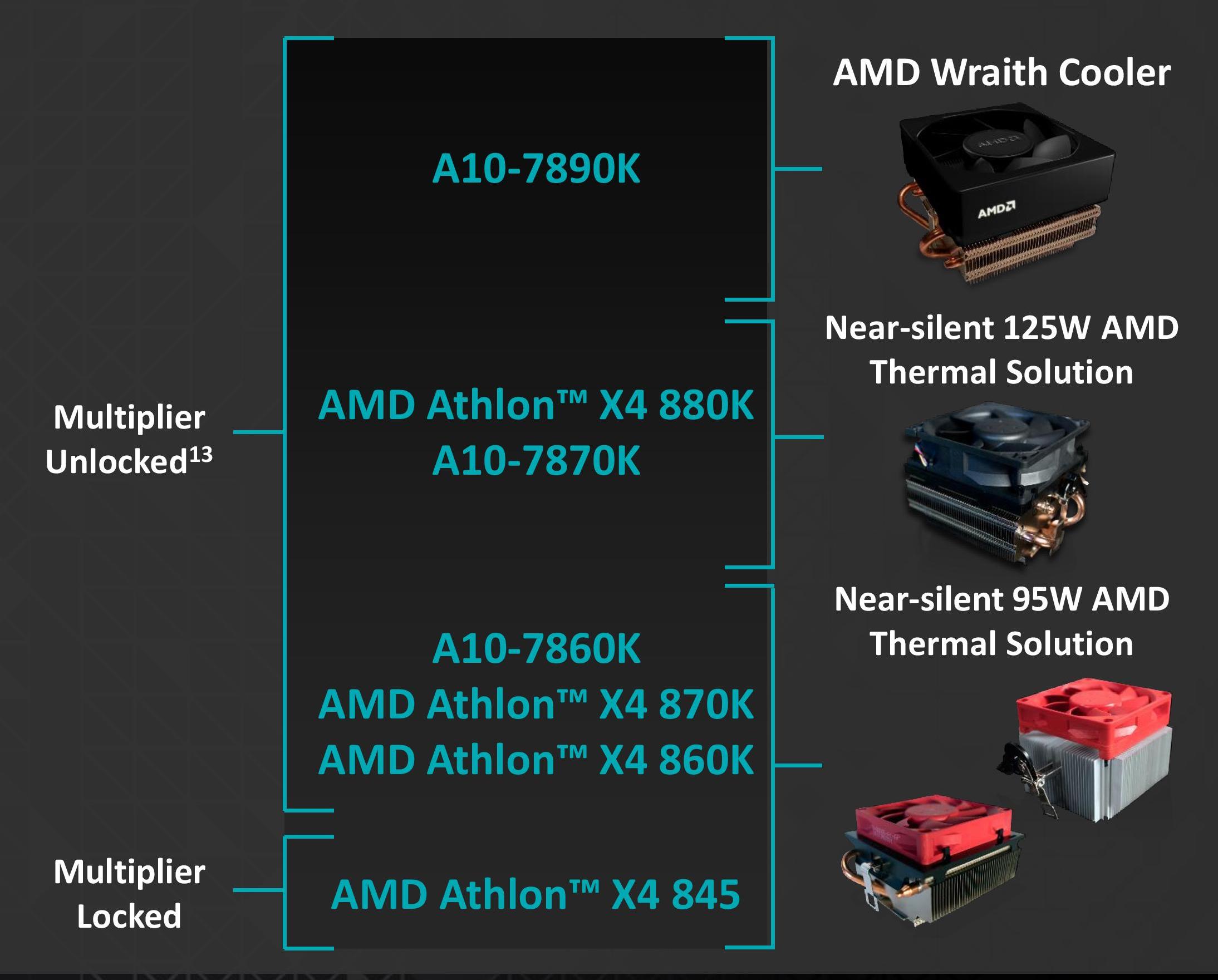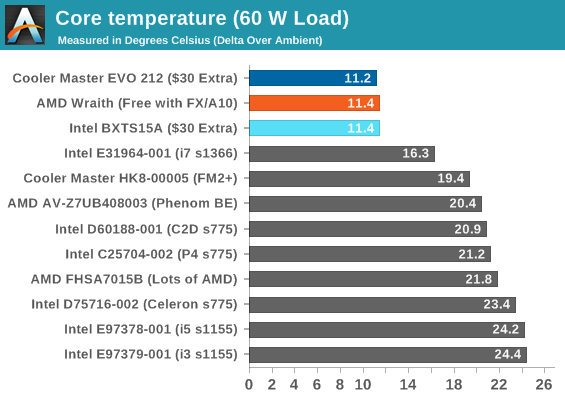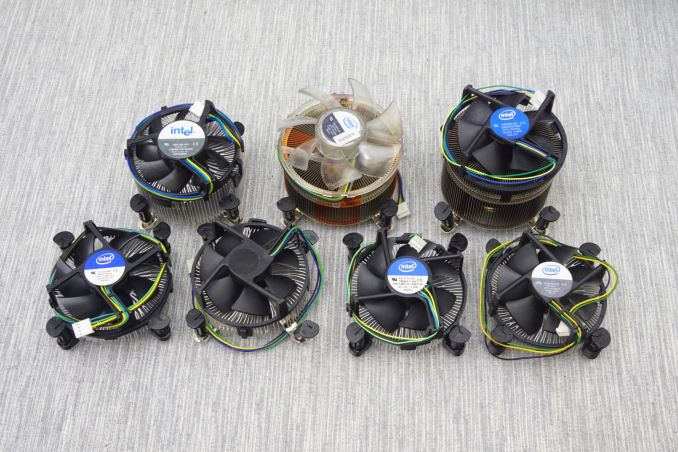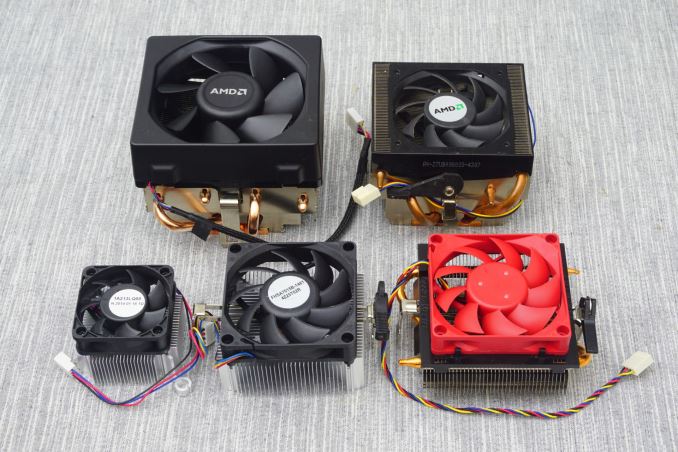Battle of The CPU Stock Coolers! 7x Intel vs 5x AMD, plus an EVO 212
by E. Fylladitakis on July 22, 2016 9:00 AM EST- Posted in
- Cases/Cooling/PSUs
- CPUs
- AMD
- Intel
- Cooler Master
- Cooler
Final Words
In this review we have put together a dozen stock coolers from AMD and Intel, going back through several years, and compared them against a popular off-the-shelf aftermarket cooler. Both AMD and Intel supply stock coolers with most of their processors as a form of 'guaranteed' to work with the processor, but not all solutions are equal, and do not take into account absolute performance or noise. Because AMD has recently launched their high-end Wraith and near-silent stock coolers with their performance processors, we actively went to source a number of these as well as the Cooler Master EVO 212 for an overall comparison.
| Vendor | Cooler | Common Bundle | Core | Fins | Fan (mm) |
Mass (g) |
| Intel | D75716-002 | Socket 775 Celerons | Alu | Alu | ≈80 | 118 |
| C25704-002 | Socket 775, P4 6x0 | Cu | Alu | ≈80 | 132 | |
| E97378-001 | Socket 1155 Intel i5 | Cu | Alu | ≈80 | 146 | |
| E97379-001 | Socket 1155 Intel i3 | Alu | Alu | ≈80 | 92 | |
| D60188-001 | Socket 775, C2D E8x00 | Cu | Alu | ≈80 | 419 | |
| E31964-001 | Socket 1366 i7-X | Cu | Cu/Alu | ≈100 | 435 | |
| BXTS15A | Aftermarket, ≈$30 | Cu | Alu | ≈80 | 362 | |
| AMD | 1A213LQ00 | AMD “Kabini” AM1 | Alu | Alu | 50 | 75 |
| FHSA7015B | Several AMD Lines | Alu | Alu | 70 | 164 | |
| AV-Z7UB408003 | Black Edition Phenom | Alu +2 Cu HP |
Alu | 70 | 374 | |
| Wraith (125W) | AMD FX-8370 AMD A10-7890K |
Cu +4 Cu HP |
Alu | 90 | 304 | |
| Cooler Master | HK8-00005 | AMD FM2+ “Godavari” | Alu | Alu | 70 | 125 |
| EVO 212 | Aftermarket, ≈$30 | Cu +4 Cu HP |
Alu | 120 | 436 |
Intel’s line of stock CPU coolers seem to have been designed to have characteristics agnostic to the requirements of the specific socket it was bundled with. The main difference between the coolers ends up being the noise that the cooler generates. For example, both of the 1155 coolers had similar absolute thermal resistance, but the copper core E97378 is significantly quieter. As one might expect, the only cooler that was an exception to that rule was the one bundled with a $1000 CPU (E31964-001). However, that does not mean that the coolers of cheaper CPUs will perform worse or necessarily be louder overall.
Cheap low power CPUs also have lower thermal losses than the high end models based on similar technology, meaning that an 'inferior' heatsink will also likely have a lower thermal load to deal with. The main difference will be discernable only when the cooler is idling, as the copper core coolers can lower the speed of their fans to nearly inaudible levels. This is arguably the best takeaway message for stock coolers: copper cores help with noise rather than absolute thermal resistance.
For AMD's coolers, there is a clear dichotomy in their cooling range. The high-end parts, particularly those at 95W and above (and the A10-7860K), get the newest and best coolers.

AMD's Cooler Lineup, with FX-8370 and FX-8350 also in the Wraith section
Most of their other CPUs come with the FHSA7015B, a cooler with mediocre overall performance that just gets the job done. Certain top tier models, such as the Godavari core FM2+ CPUs, come with advanced models that do offer higher overall performance and lower noise levels. The performance of these coolers may not be on par with mainstream tower coolers comparable to the Cooler Master EVO 212, but it is an upgrade comparable to buying an entry-level $15-20 tower aftermarket cooler and meeting the EVO half-way, in a sense. Only the latest 125W Wraith cooler is an exception, greatly outpacing even the Cooler Master HK8-00005 and AMD AV-Z7UB408003, coolers that were or are being supplied with other top tier CPUs.
Conclusion: AMD's Wraith is a Great Free $30 Upgrade
It's clear from the market that AMD is taking a broader interest in coolers recently, whereas Intel has taken a different direction with the new Skylake-K CPUs being sold without stock coolers. It creates an interesting platform where a good cooler might add to the cost of a processor, whereas the high performing CPUs remove their stock coolers to become more price competitive (even if you have to spend another $30 to get a cooler anyway).
But naturally, our conclusion is going to be dominated by the top performers of this roundup - the Intel BXTS15A, the AMD Wraith and the Cooler Master EVO 212.
AMD is supplying the Wraith for free alongside their top tier CPUs and it proved itself capable of performance comparable to that of a reputable mainstream cooler such as the Cooler Master EVO 212. The Wraith’s high thermal performance can be attributed to the strong 90 mm fan and heatpiped design. This saves the average user from spending a significant monetary sum for a good, silent cooler, as the Wraith is more than enough for everyday use and even for reasonable overclocking. For those that are interested, the AMD side lights up when powered as well.


Intel supplies the BXTS15A as an aftermarket cooler, an upgrade over the stock coolers supplied alongside their CPUs. However, it hardly makes sense as an upgrade. There are several better aftermarket CPU coolers better than the BXTS15A with the same price tag, including the Cooler Master EVO 212 that was showcased in this review.
Most of Intel's CPU coolers are rated as 'good enough' for the platforms they target. However, there is no guarantee of long-term stability (note, dust) and we can see that audible performance when pushing a CPU can be excessive. If the BXTS15A was being supplied alongside a CPU then it could prevent some users from upgrading to better coolers, or it could be a viable option if it was selling for less than $20, but has little to no market value as a standalone product at such a retail price. If there are no space constraints or other mechanical issues (mounting security/strength, portability, etc.), then the recommendation is that a user bypasses the BXTS15A and moves straight on to something like the Cooler Master EVO 212 or other comparable aftermarket cooler.
A side note about noise:
It is rather ironic that both AMD and Intel are marketing their best coolers as “quiet” models, as they were among the loudest that we have tested here today when their fans were forced to operate at absolute maximum speed. AMD has stated that the Wraith 'shroud' over the top of the cooler is a few db louder (due to vibrations) than the near-silent variant, but affords additional lighting to show off the system. The catch with both the AMD and Intel solutions is that both of these coolers will actually be quiet when they replace the louder stock coolers that CPUs usually ship with, especially the smaller heatsinks of the cheaper models, although the Intel variant is an extra outlay. If the Wraith or the BXTS15A are installed on a stock CPU, their mass is enough to keep the CPU cool without relying much on airflow, allowing the thermal control of the motherboard to keep the fan’s speed (and noise) very low. It comes down to the cost of such a difference.
Cooling performance can change quickly if the CPU is constantly under heavy stress and/or overclocked, as the thermal losses of the CPU multiply under such conditions. Both companies obviously wanted to ensure that their top end coolers can hold the processors cool enough even under such conditions and thus they are using very strong fans that can provide high levels of airflow if needed. Ultimately the best way to increase airflow in these situations is with larger fans that run slower (such as the EVO), but this can be difficult when staying within specifications or having to design basic coolers to a price point without taking a loss.














82 Comments
View All Comments
yannigr2 - Friday, July 22, 2016 - link
Your comment makes you look stupidly indeed. A company is giving a top quality cooler that saves you $20-$30 and you find it stupidly sad?SetiroN - Friday, July 22, 2016 - link
Yes, I find the fact that the best thing a CPU manufacturer's got going is their bundled cooler extremely sad.yannigr2 - Saturday, July 23, 2016 - link
Some people will find sadness in everything AMD does. At the same time they will praise Nvidia or Intel for doing the exact same thing.DanNeely - Friday, July 22, 2016 - link
I disagree. While part of this demonstrates clearly what most of us already know; most stock coolers suck. It also shows that AMD actually did deliver a good stock cooler in the Wraith. Cooling wise it matches the budget standby Cooler Master 212; and comes close to matching it in terms of sound as well making it the first stock cooler I wouldn't automatically recommend trashing for an aftermarket job.If I were nit picking, I'd've liked to've seen an affordable non-tower aftermarket cooler in the mix as well because slim profile cases don't have room for big towers. OTOH by including a 212 in the mix this article can be used as a baseline to compare testing results on them elsewhere.
A5 - Friday, July 22, 2016 - link
Meh. If AT is going to get back in the CPU cooler review game, this is a good place to start for two reasons.1) Make sure they're starting from a good assumption (stock coolers suck).
2) Compare it to the current most popular replacement.
From there, you can start adding in higher-end coolers and comparing them to the baseline.
Ratman6161 - Friday, July 22, 2016 - link
I don't necessarily agree that "stock coolers suck". They suck for most of the people who would be reading this article in the first place :) but are generally more than adequate for people running their system at stock speeds and more or less typical conditions.I think Intel has essentially taken the right approach. Bundle a good enough cooler with most CPU's since they are adequate to the task and the people using them won't know the difference anyway. Sell the "K" CPU's without a cooler. If you are buying a K, then then you are probably also a person who wants to chose their own cooling solution too. Everybody wins.
JoeyJoJo123 - Friday, July 22, 2016 - link
Except in the latter case you're actually losing.They USED to bundle the stock cooler, and even if it wasn't used permanently, it was certainly useful for testing boot or as something to hold you over until you save another ~$100 for an all-in-one CLC that couldn't fit your initial PC budget.
I'd be all in if the lack of the stock cooler also meant they dropped prices on those same kinds of CPUs, but the prices actually went up AND they lost the stock cooler. Double loss for the consumer.
mikato - Thursday, July 28, 2016 - link
I bought non-K Intel CPUs (and AMD CPUs) and aftermarket coolers. Up to this point, I had useless stock coolers that NEVER got used since most of the time I bought a decent aftermarket cooler at the same time I build the computer. There is no point selling them on ebay. They were just an unfortunate waste of resources.So now I appreciate both strategies. Either don't include a cooler (and its price), or include a decent budget cooler (for less added price than a low-end aftermarket cooler). Both work for me. But as you say, if Intel hasn't passed on that cost saving then that isn't good.
It would be interesting to know how many people that build their own computers also use a non-stock CPU cooler (excluding the higher end Intel and AMD's Wraith). And how has that evolved over time since CPUs produce less heat now, and since budget coolers have improved quite a bit for their price.
To me water cooling is just plain unnecessary and has been for a long time. Air cooling does easily well enough, for less money, and less hassle. You don't get much for spending the extra money.
JonnyDough - Monday, August 1, 2016 - link
Best comment. I have about 18 desktop PCs, all of them from the last 6 years or so. Only one has a stock cooler and that's my HTPC, because it's so watt that it's quiet with the stock and sits in my living room far from me. I also think water cooling is a waste, when all one needs is a good cooler and some case fans. Water cooling nets just a few degrees difference in ambient case. If your VRMs are getting hot because the mobo maker didn't put a heatsink on it, just throw some cheap heatsinks on it.dishayu - Friday, July 22, 2016 - link
It IS useful. It helps put definite numbers to the theory that we already know to be true (that stock coolers suck). It tells users how much of a benefit they would get, going from their stock cooler to a 212 Evo (and subsequently other coolers they test in the future).This is good work, show some respect.